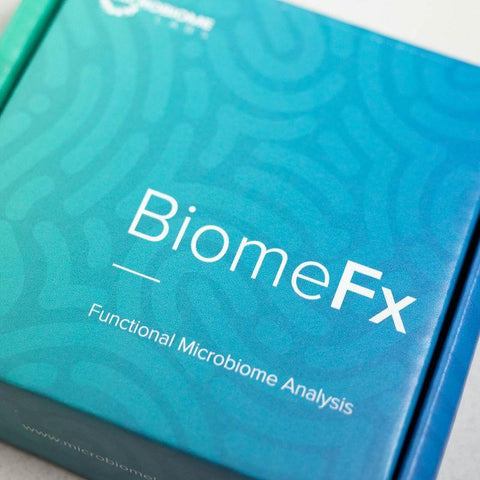
Biome FX Stool Test
Log in to purchaseA New Way to Test — Whole Genome
Recent evidence suggests that the gut microbiome is likely the master control center of overall human health. In recent years, stool testing has become a popular method to evaluate the status of an individual’s gut microbiome (1). Peering into these microbial ecosystems can offer insight into disease susceptibility and potential root causes of illness. In fact, many diseases have a unique ‘microbial signature’ or enterotype, which means that specific bacterial patterns can be consistently linked to a particular disease. Fecal sampling can help clinicians and patients understand how their gut bacteria may be contributing to their ailments and how they can improve their gut microbiomes (2). However, common methods of stool analysis are often inaccurate, and many reports offered to consumers are confusing, ambiguous, and not actually based upon scientific evidence.
The most commonly used analysis techniques include 16S rRNA gene sequencing (16S) and quantified polymerase chain reactions (QPCR). Essentially, 16S rRNA is a region of DNA present in all bacteria and archaea, but not necessarily in other microbes, such as fungi or viruses. The 16S gene contains 9 hypervariable regions that can be thought of as a barcode, encoding many bacterial taxa (2). This area of DNA is then amplified using QPCR techniques to predict the full DNA sequence. However, due to its imprecise predictive nature, QPCR offers vague and often inaccurate results.
Similarly, researchers have found that 16S genome sequencing has less than 50% accuracy in identifying microbial species (3). It offers insight into phyla and genera, but due to its use of low-resolution images, it does not offer enough precise detail about bacteria at the species level, which can be very important! For example, the bacteria Escheria coli has many strains. Some of these are pathogenic, while others strains of E. coli are protective. Furthermore, 16S is unable to distinguish between living or dead cells, or offer insight into their metabolic activity.
Instead of 16S rRNA and QPCR, BiomeFx™ uses whole genome sequencing. Instead of targeting one specific gene region, such as the 16S region, this thorough approach gathers a more complete picture by using multiple, overlapping gene primers. A recent study found that whole genome sequencing identified nearly twice as many bacterial species compared to 16S methods, providing more information on microbial richness and diversity (4). This is a stunning finding as individuals using 16S methods may receive faulty dietary and lifestyle advice in response to these testing methods. Whole genome sequencing is far superior and allows clinicians to more accurately provide interventions to heal and balance the gut.
Moreover, BiomeFx™ is distinct from other stool tests because of its unique coring method, which increases the accuracy of samples. Rather than taking a sample from the surface of the stool, this approach gathers data from the core of the sample and presents the findings into a functional report. This functional report will look at microbial trends and patterns to understand what the gut microbiome is doing rather than presenting the data in a meaningless range of high to low. These common reports are confusing, unhelpful, and not backed by scientific research. BiomeFx™ is the superior stool test on the market because of its coring method stool sampling, highly accurate whole-genome analysis and practical, user-friendly reporting.
